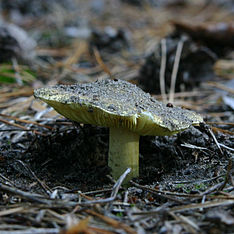Tricholoma equestre
| Tricholoma equestre | |
|---|---|
 |
|
|
Tricholoma equestre, Massachusetts, USA |
|
| Scientific classification | |
| Kingdom: | Fungi |
| Division: | Basidiomycota |
| Class: | Agaricomycetes |
| Order: | Agaricales |
| Family: | Tricholomataceae |
| Genus: | Tricholoma |
| Species: | T. equestre |
| Binomial name | |
|
Tricholoma equestre (L.) P.Kumm. |
|
| Tricholoma equestre | |
|---|---|
| Mycological characteristics | |
| gills on hymenium | |
| cap is flat | |
| hymenium is adnexed | |
| stipe is bare | |
| spore print is white | |
| ecology is mycorrhizal | |
| edibility: not recommended | |
Tricholoma equestre or Tricholoma flavovirens, also known as man on horseback or yellow knight is a formerly widely eaten but hazardous fungus of the Tricholoma genus that forms ectomycorrhiza with pine trees.
Known as Grünling in German, gąska zielonka in Polish, and canari in French, it has been treasured as an edible mushroom worldwide and is especially abundant in France. Although it is regarded as quite tasty, cases of poisoning from eating T. equestre have been reported. Research has revealed it to have poisonous properties.
Tricholoma equestre was known to Linnaeus who officially described it in Volume Two of his Species Plantarum in 1753, giving it the name Agaricus equestris, predating a description of Agaricus flavovirens by Persoon in 1793. Thus this specific name meaning "of or pertaining to horses" in Latin takes precedence over Tricholoma flavovirens, the other scientific name by which this mushroom has been known. It was placed in the genus Tricholoma by German Paul Kummer in his 1871 work Der Führer in die Pilzkunde. The generic name derives from the Greek trichos/τριχος 'hair' and loma/λωμα 'hem', 'fringe' or 'border'.
The species may be in need of further analysis given the conflicting reports of toxicity.
Common names include the man-on-horseback, yellow knight, and saddle-shaped tricholoma.
The stem is yellow, usually about 4 to 10 centimetres long with an even diameter. The gills are also yellow colour and the spores are white. The cap is usually a yellow to yellow-green sometimes with a touch of brown to brown-reddish colour. The diameter is usually from 5 to 12 centimetres in length. The skin layer covering the cap is sticky and can be peeled off.
...
Wikipedia
